A hog on a handline
An in-depth look at the world of walleye handlining
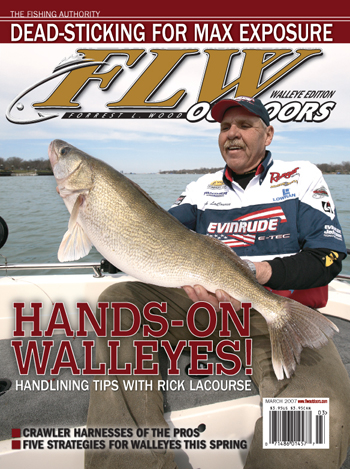
Troy Morris didn’t consider himself a handliner before that frigid tournament on the Detroit River in early April 2006. But as the Bismarck, N.D., angler chugged along into the Detroit’s current over a deep breakline in front of an area known locally as the Salt Mines, lifting and dropping a 2-pound weight in and out of crevices in rocks, sunken cars, concrete and who knows what else on the river bottom, he knew he was doing the right thing. Several feet behind the weight were a pair of big, bright stick baits, surging through the swift water and pausing subtlety over the same crevices.
Good as all that cover may have been for walleyes, it was nearly impossible to jig as it was 30 feet deep and very swift. Snags were inevitable. A few anglers were jigging higher up on the breakline in shallower, slower water. Morris felt most of the fish, particularly big ones, were holding in darker depths, however.
Suddenly, as Morris made another lift, there was much more resistance on the line, and then a telltale headshake – fish on. Feeding the 60-pound wire back into the reel, Morris began working the setup to the boat as his co-angler waited intently with the net.
Two monofilament leader lines came into view, and one of them was pulling out to the side. Gingerly, Morris worked the rest of the wire and the slack lead into the boat and grabbed the taught monofilament. A giant mouth full of teeth flopped on the surface before being scooped into the net. At 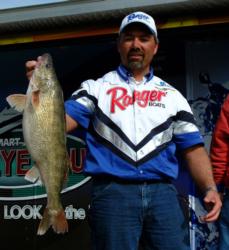 10 1/2 pounds, the walleye anchored a four-fish, 21-pound, 8-ounce catch for Morris on day two of the event. It helped Morris finish in the top 10 at the first Wal-Mart FLW Walleye Tour event of the 2006 season.
10 1/2 pounds, the walleye anchored a four-fish, 21-pound, 8-ounce catch for Morris on day two of the event. It helped Morris finish in the top 10 at the first Wal-Mart FLW Walleye Tour event of the 2006 season.
“The first time I ever fished a tournament with a handline was at the Detroit River event in 2006,” Morris said. “I purchased the equipment and familiarized myself with it at home on the Missouri River. I wanted to concentrate more on deep fish, those that were 26 to 33 feet deep in the Detroit. I felt like that’s where the largest fish were holding, right in that current, and a handline was the best way to catch them.”
If you know your walleye history, then you know there is no better place to learn handlining than on the Detroit River. Before the days of powerful electric trolling motors that allowed anglers to “slip” with the current and jig vertically, jigging on the Detroit was tough. If a jigger’s line is anything but perfectly straight up and down for more than a second or two, chances are it’s going to get snagged. Those thousands of snags are perfect hiding places for walleyes, but death on jigs.
“Handlining was designed on the Detroit River to fight the current,” said Rick LaCourse of Port Clinton, Ohio, regarded by many as one of the best handliners on any walleye tournament trail. “It was a method for the fisherman to simply gain control of his baits in strong current. It’s not unlike other types of fishing – it’s just that your arm acts as the rod and your hand acts as the drag. With slight modifications to a handline setup, I’ve used it all over the country, in rivers and even some lakes, with good success. I’d say I’ve won a quarter of a million dollars by handlining alone.”
Handline setup
Though simple in theory, handlining does require a few key pieces of startup equipment to be successful. The first is a spring-loaded reel with wire. This device takes up slack wire when fighting a walleye to the boat or when moving from deeper to shallower water. It’s mounted on the side of the boat about six feet forward of where the handliner sits. Professional walleye anglers usually rig their boats with two handline reels – one for the pro and one for the co-angler. Since walleye boats have very small or no back decks, most seasoned handliners opt to install seats of some sort. LaCourse simply uses folding camp chairs.
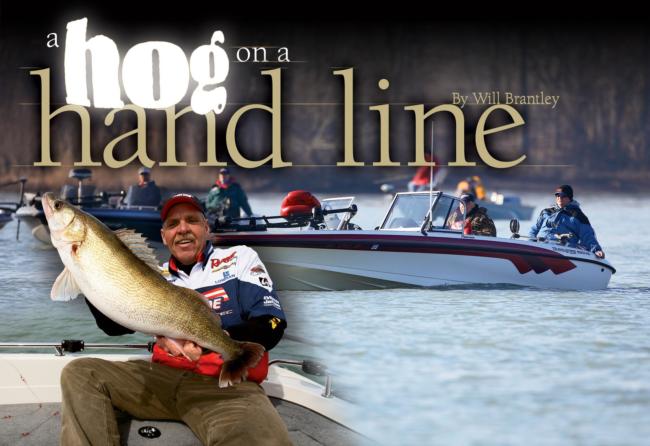 Some of the first handline reels were made from modified Victrola music boxes and various types of wires. These days, a few handline reels are commercially manufactured. Most pros opt to use the Kachman reel made by Riviera. Kachman reels come pre-spooled with 200 feet of plastic-coated 60-pound wire.
Some of the first handline reels were made from modified Victrola music boxes and various types of wires. These days, a few handline reels are commercially manufactured. Most pros opt to use the Kachman reel made by Riviera. Kachman reels come pre-spooled with 200 feet of plastic-coated 60-pound wire.
“I prefer plastic-coated wire,” LaCourse said. “It’s much easier on my hands. But some of the old-timers like uncoated wire because they say you can feel more with it.”
Another section of wire, called a shank, is attached to the wire main line. A shank is basically five more feet of wire with clevice attachments for lure leaders. Morris buys his shanks pre-tied. Kachman reels are shipped standard with a prepared shank as well.
“I like to tie my own shanks,” LaCourse said. “I start with 5 feet of the 60-pound coated wire and set a clevice every six inches along the shank.” Doing so allows for more fine-tuning in bait positioning.
At the bottom of the shank, a large, heavy swivel is needed for attaching weights of various sizes. Handlining weights are heavy, ranging from 3/4 of a pound to 2 pounds. Depending on the current, depth and trolling speed, anglers need to keep several different sizes on hand.
“You want your handline to always be at a 45-degree angle to the boat – never straight up and down,” Morris said. “That’s how you choose your weight size. Speed and current choose it for you.”
“In really deep water, like something in excess of 35 feet, you have to go to a heavier weight,” LaCourse said. “Once the angle of your handline exceeds about 60 degrees from the boat, you’re just haphazardly dragging it, and you no longer have control of your baits. It defeats the purpose of handlining in the first place.
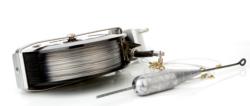 “The weights I use have a wire through them and are 13 inches long,” LaCourse continued. “Ninety percent of my fishing is done with 1- to 1 1/4-pound weights.”
“The weights I use have a wire through them and are 13 inches long,” LaCourse continued. “Ninety percent of my fishing is done with 1- to 1 1/4-pound weights.”
With the main wire line, shank and weight in place, it’s time to rig the business end of a handline – the leaders and lures. For most anglers, this begins with a couple swivels and heavy monofilament.
“I use a large swivel to attach the leader to the clevice,” Morris said. “This keeps the leaders from getting all twisted up if the bait gets fouled. It also allows me to rapidly adjust the height or length of my leaders if need be.”
Morris chooses stiff, 30-pound monofilament for his handlines. Since handlining is typically a muddy-water presentation, the large line doesn’t seem to bother walleyes. The most important reason to use heavy monofilament is that it doesn’t tangle as easily when pulled into the boat. LaCourse uses something slightly smaller, usually 20-pound Berkley XT or Big Game mono.
Both anglers use snaps to connect their crankbaits to the lead lines. Occasionally, LaCourse handlines spinner rigs or crawler harnesses. For these spinning setups, he substitutes lure snaps with another small swivel to further avoid twists and tangles.
Lure choice
“Typically, when the water gets dirty, it’s the best time to use a handline,” Morris said. “You’re putting those stick baits right in a walleye’s face and holding them there.”
Morris referred to stick baits on handlines because when most people think of the technique, large Rapala Floating Minnows come to mind. Indeed, Morris was running big, brightly colored No. 11 Rapalas at Detroit. Early season walleyes in deep, cold water seem to prefer a sizeable, easy-to-see, tight-wobbling bait.
But LaCourse pointed out Rapalas aren’t the only thing that will work on the end of a handline.
“Basically, any floating minnow bait will work,” LaCourse said. “Most of the press has been on stick baits, and I probably use those more than anything. Some of my favorites are floating Smithwick Rogues and Storm ThunderSticks. I like more natural colors, such as black and silver, black and gold and vampire in cleaner waters. If I’m targeting muddy water, say sauger fishing in the Illinois River, then I like brighter colors such as chartreuse, orange, pink and white.
 “At times, walleyes are feeding more on shad than minnows, and I’ll change to a shallow-running Shad Rap or some other shad-style bait,” LaCourse said.
“At times, walleyes are feeding more on shad than minnows, and I’ll change to a shallow-running Shad Rap or some other shad-style bait,” LaCourse said.
But don’t think for a minute handlines will only work with crankbaits in heavy current. LaCourse has used the setup with spoons, minnow spinners and even crawler harnesses with success.
“At certain times of the year, crawler harnesses are really effective, as are spinners, minnows and spoons,” LaCourse said. “There was a local lure made near Detroit called the McGinty – it was just an inline spinner made on a wire with a treble hook. You could put half a crawler on that treble hook, and it was deadly. You just have to use your imagination.”
Finding the perfect depth for your baits and the proper length of leader to use is the next step. The standard starting point is 15/30 – a 15-foot lead on bottom and a 30-foot lead on top.
“Most everyone starts with a 15-foot lead, moves up the shank three clevices and attaches a 30-foot lead,” Morris said. “But whatever length you use, always remember the longer lead is on top, and it’s always double the length of the bottom lead.”
Moving the leads up and down the shank adjusts the depth of your baits.
“You adjust your lure by two inches each time you switch your lead to the next clevice,” LaCourse said. “If I hang a lure and break it off, sometimes I don’t do anything to the lead – I just use the broken, shorter one and attach a new lure. That’s often the best way to tune the length of your leads.”
Handline effectiveness
The heavy weight and absence of a rod makes handlining one of the top choices for covering water in extremely heavy current. Keep your setup at a 45-degree angle, and you know your baits are wobbling right there behind it in the strike zone. Trolling slowly with a zigzagging path into the current is an effective way to thoroughly cover water on rivers.
But it’s not limited to rivers. Just as reservoir techniques will work in some river situations, handlines will work on a lake.
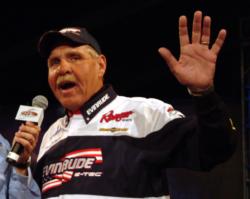 “I can efficiently cover structure, even on a lake, keeping a bait in the strike zone the whole time with a handline,” LaCourse said. “I’ve done it on Lake of the Woods around rock piles, and I’ve done it fishing structure on Lake Erie. So many times, you fish new water and fall into the `local method’ trap. But when I get to a new fishery and I have a bait that I know will catch fish, sometimes it’s just a matter of figuring out the best way to present that bait.
“I can efficiently cover structure, even on a lake, keeping a bait in the strike zone the whole time with a handline,” LaCourse said. “I’ve done it on Lake of the Woods around rock piles, and I’ve done it fishing structure on Lake Erie. So many times, you fish new water and fall into the `local method’ trap. But when I get to a new fishery and I have a bait that I know will catch fish, sometimes it’s just a matter of figuring out the best way to present that bait.
“Oftentimes, a handline will keep a bait in the strike zone longer than anything else,” he continued. “I can put a crankbait down there and know where it is and how it is running 100 percent of the time, whereas guys who are flatline trolling with lead core don’t always know.”
Fighting fish
Fighting a big walleye on a handline is an art in and of itself. Many handliners have their own different techniques and methods for wrestling a hog on a handline.
The fight begins with a strike, which can be tough to detect on a handline.
“You don’t feel a lot,” Morris said. “Basically, all you feel is a tug and some extra weight on the line. When you pull forward, then you can feel that head shake.”
With heavy monofilament and heavy wire line, there is no stretch. Combine that with forward boat movement, swift current and a lure covered in hooks, and setting the hook by yanking the handline becomes counterproductive. The hook is set when a walleye strikes.
“I’d say 95 percent of your strikes occur when you pull the weight up and drop it again, letting the bait go backward before surging forward into the current,” LaCourse said. “You’re lifting the handline with 6- to 12-inch drops, causing the bait to speed forward and backward. The fish can do one of two things – get out of the way or grab the lure. As soon as you detect the strike, get control of the fish and start bringing him up.”
As you fight the fish, let it run and take line by simply allowing the wire line to slip through your fingers. This acts as your drag. Until the lead lines are brought to the surface, it’s tough to know which line the walleye is on.
“Once you get the main line in, you can figure out which lead the fish is on,” Morris said. “It’s probably going to be the one that’s not straight out behind the boat. Usually, the fish will pull it to one side or the other.”
Once you determine which lead the fish is hooked on, the situation can become a little tricky. Techniques for landing a fish on one lead aren’t necessarily the same as for landing it on the other.
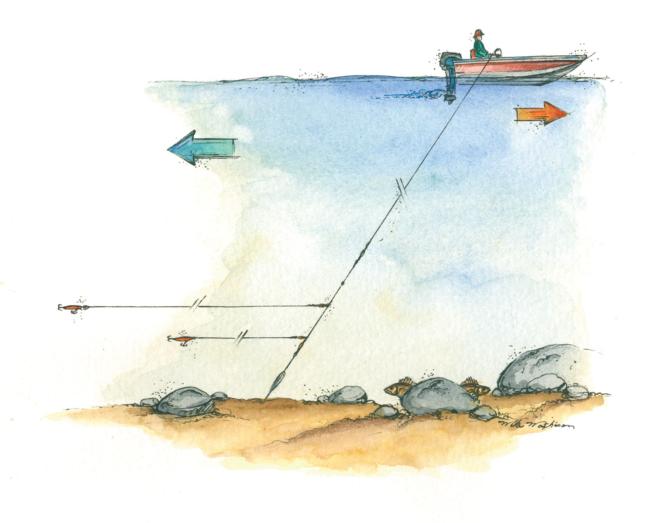
LaCourse always fishes from the starboard side of the boat. As he’s bringing his fish in, he guides the wire back onto the reel with his left hand while pulling it up with his right hand. Once he has the lead line within reach, it’s time to get serious.
“If the walleye is on the top lead, I’ll take the wire that’s in my left hand and wrap it around one of my rod holders while maintaining a hold on the lead line and release the weight into the water,” LaCourse said.
Wrapping the wire around the rod holder allows him to release the weight without it pulling wire off the reel and going back to the bottom of the river. It effectively gets it out of the way so he can fight the fish on the lead line.
“As I pull lead line through my hand, I lay it inside the boat and steer the fish with my right arm,” LaCourse said. “If he needs to run, I let him run on that slack line. When he’s ready to be netted, I bring him up and my partner nets him.”
Walleyes hooked on the shorter bottom lead line tend to fight straight down. At this point, once the leads are in sight, it’s important to get the longer top lead out of the way. This is also where that stiff monofilament comes in very handy.
“When the fish is on the bottom lead, I grab the top lead and the wire on the bottom in the same movement,” LaCourse said. “I take the top lead up and over my shoulder so it’s high and out of the way, and I bring the weight into the boat. As you’re doing this, it’s important to always keep control of the fish and never give him any slack.”
On the shorter line, there’s even less room for error. The line won’t stretch, so the fish can easily tear away. Morris said it’s sometimes even necessary to drop the weight back into the water so the fish can have enough line to tire down.
Catching a big walleye on a handline is different than any other type of walleye fishing tactic, but it works beautifully. If you don’t take the time to learn the method, particularly if you spend any time fishing rivers, you’re probably missing out.
Handlining safety
Because you’re holding onto heavy metal wire and dragging a big weight on the bottom of snag-infested rivers, there are some safety factors to keep in mind when handlining.
If a handline gets snagged, it won’t stretch – it will simply stop and tighten. If your fingers are in the way of the wire as it tightens, they will be cut. Never wrap the wire around your fingers or hand while working it – this can result in severed fingers finding their way to the river bottom, and that will effectively end your day of fishing.
Instead, keep the wire resting in the bends of your fingers and grasp it with your thumb. Let it slide in and out of your hand as need be, but always be prepared to let go should you be surprised with a sudden, jarring snag. In a place like the Detroit River, there are snags running the gamut. You may free your line from a rock if you yank hard enough, but the odds of moving something like a sunken bus are pretty slim.